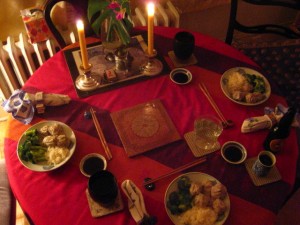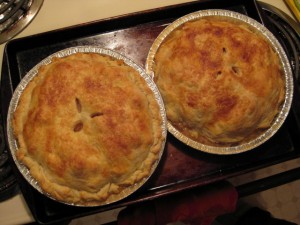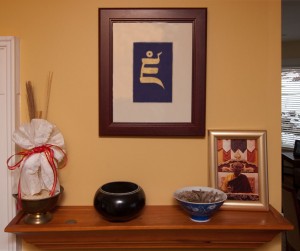Friday
Featured StoriesWhat is a Shambhala Household?
In conjunction with the Sakyong’s recent teaching and emphasis on Shambhala Household, we asked Wendy Friedman and Noel McLellan to share their thoughts on the topic. Sangyum Wendy Friedman is the newly appointed Director of the Office of Culture and Decorum. Kusung Dapon Noel McLellan is a senior officer of the Kalapa Court.
What is a Shambhala Household? And what is its relationship with the Kalapa Court?
Noel McLellan: Generally we think of our own homes, our household, as the centre of our lives. Our household is a manifestation of our view, our lifestyle, and our culture.
Household is also the centre of the Shambhala mandala, which is the Kalapa Court, the home of the Sakyong and Sakyong Wangmo. It’s very significant that the centre of Shambhala is a home, rather than a temple, office, or headquarters. The Kalapa Court is not just a home for the Sakyong and Sakyong Wangmo in a utilitarian sense. It’s where Shambhala vision and dignified human culture are fully embodied and lived. It signifies that at the heart of our vision for enlightened society is the union of sacredness and everyday life.
In my experience, the Kalapa Court is a very potent place. The environment there is very uplifting, rich, and awake. At the same time, it’s very ordinary–dishes are being washed, food is cooking, Rinpoche and Khandro-la are living their lives. It’s also playful and fun. So it provides an example for how to live as a Shambhala householder.
“A warrior never needs to take time off.”
– Dorje Dradul of Mukpo
Wendy Friedman: We all know that our dedication to basic goodness, discipline and compassion does not dissolve at the shrine room door. In the Shambhala tradition, we have been taught to rejoice in the richness that we can experience as householder practitioners. The Sakyong is turning our focus to the concept of Shambhala Households as a structure for further developing post-meditation practice in our daily lives.
Shambhala Households are individuals, families or groups of people who wish to live by Shambhala principles and to cultivate an atmosphere of awake, uplifted cheerfulness in their homes. Rather than seeing our home life as a burden, or as a distraction from practice, we could fully embrace our domestic life and apply the Shambhala teachings to our living situation.
How can establishing a Shambhala Household enrich our lives as practitioners?
Wendy Friedman: The Sakyong has said that living in Shambhala Households can help us to see the continuity between our lives as practitioners and our home and family life. When we are able to manifest an atmosphere of warmth and delight in our homes, we can invite others into that–and celebrate our dignity together. The forms and culture of Shambhala are an upaya, or skillful means, for helping us to access our sanity at any time. If we integrate Shambhala forms into the way that we cook, entertain, raise our families and arrange our spaces, then our environment becomes a reminder to live wakefully.
“Take delight in others and propagate dignity.”
– Dorje Dradul of Mukpo
Noel McLellan: As Shambhalians aspiring to connect with primordial goodness, and to live and express that in our homes, we already have a powerful energetic connection with the Kalapa Court. In some sense, the purpose of the Court is simply to inspire us; to empower us in our lives so that we don’t just regard everything as mundane and as a hassle. Further, we can take our seats as sakyongs and sakyong wangmos in the centre of our lives. The challenge often is just remembering that. Setting up our household based on the example of the Court reminds us, and supports our ability to hold the view.
Wendy Friedman: Sometimes our homes can become a place to “hide out” or flop. Because we all work hard, there can be an urge to collapse when we get home. We do need to rest and rejuvenate, but it is also important to rouse ourselves in creating a home that inspires us, rather than a cave or cocoon.
What recommendations do you have for transforming our homes?
Wendy Friedman: We can begin quite simply. Keeping the environment of our home clean and arranged with attention to detail is a great foundation. The Sakyong has been speaking frequently about the importance of a good hearth–as represented by a clean stove in our modern homes. The hearth or stove is said to be the source of confidence and energy in the home. Group or family dinners are another way to practice as a household. Gathering with friends or family to enjoy a nice meal binds us as a community. We may eat simple food, but we can prepare it with good quality ingredients, and offer it at a table that has been set with care.
“Join survival and celebration.”
– Dorje Dradul of Mukpo
We can invite drala by establishing a kitchen shrine, and taking a fresh look at our existing shrines for ways that we might enrich them. Some households may want to sit down together to choose some goals for uplifting their living situation–such as saying the protector chants together each evening, setting certain nights aside as “family/household time” or creating guidelines for practicing more kindness of speech with one another.
Is the Sakyong’s emphasis on Shambhala Households something new?
Noel McLellan: These are not new teachings, so seeking out and studying Chogyam Trungpa Rinpoche’s talks on the subject could be a good way to connect with the view. Also, many senior practitioners have been drawing on court principles in the way they live their lives and arrange their homes for a long time now. If you know any, invite them over for tea!
Wendy Friedman: I remember, growing up in Shambhala, that many families had “Shambhala Households.” Back then, there was no formal process that I knew of – but there were certain principles that people were trying to work with in their homes. It was one of the major shifts away from the hippie culture of that time. Some families or groups of people would share houses so that they could create households together.
I think that it can be an antidote to our current times of speed, materialism, and digitalization to engage in our home life in an earthy, hands-on way… to cook good meals, arrange nice flowers,
have good dinner conversation, and make protector offerings.
To Learn More and Contribute Your Ideas…Shambhala Households are a central part of our lives as Shambhala practitioners. As the possibilities and directions unfold, we will be posting new information on the new Culture and Decorum webpage on Shambhala.org under Community.
In addition, this spring the Shambhala Times will inaugurate an online community forum for where everyone can post ideas or questions regarding Shambhala Households. Here are some examples of the type of topics that people may want to consider and discuss in community gatherings, with delegs or friends:
What are your experiences and thoughts on…Dining: alone or with others; with friends or neighbors; formally or informally.
Meal chants: alone or with others; when with non-sangha or in public venues.
Neatness: avoiding the extremes of clutter or compulsive cleaning.
Television viewing: as indulgence or relaxation?
Entryways: inviting and/or protecting our households.
Attracting dralas: household environment and our behavior.
Food shopping: seasonal, local, affordable and/or sustainable.
Cooking: creative ideas and practicalities.
Eating: a time to appreciate taste and/or a time for social interaction.
The dining environment: creative ideas and practicalities.
Photos courtesy of David Brown. The image of the flags and kitchen shrine are from the Kalapa Court, residence of the Sakyong and Sakyong Wangmo in Halifax, Nova Scotia.









Jul 20, 2011
Reply
Does anyone know where I could buy the calligraphy?
Jun 9, 2011
Reply
I love the comment about humor. As a long time foodie, I love making new taste combinations. If you want to walk down this road you need to have a sense of humor about it. Some of my “creations” are a source of teasing to this day, but some have entered into the “favorites” area for regular reproduction. You cannot take yourself, your life, your job, your cooking too serious or you will have absolutely no fun in life. I think that that is part of what makes a Shambhala household, warmth, sense of humor, welcoming. Just remember, everything can be fixed, words cannot be taken back, and you have to break an egg to make an omlet :)
Jan 10, 2010
Reply
Auspiciously we had decided to mount a play about a Shambhala household here in Baltimore as an offering at our Shambhala Arts Festival in March before this topic aired. Anyone who would like a copy of the script or Jack Niland’s collaborative format by which the production will happen should contact me at [email protected].
All of this goes back to the dharma/Shambhala Art teachings of the Vidyadhara. And also auspiciously Santa left a copy of “Clean Up Your Clutter with Feng Shui” by Karen Kingston under the tree. It looks very good. We shall see. Clutterbusting is not my strong suit! Cheerful New Solar Year, Judy Bond
Jan 4, 2010
Reply
I think one of the key points is how we deal with conflict in daily life. I have long felt it would b egreat to develop a culture a very simple mechanism undertsanding of how to talk about conflict once you realise you are in it between spouses parents and children housemates whatever. otherwise for me it all gets a bit too vanilla-ish. shambhalian schmalz. i have thought about this alot but have not come up wiht any great ideas or managed to integrate it as yet altho I am manging to create more space for myself in conflict. The only tool I am aware of is NVC. I would be happy to contribute time and effort in this area and I forgot to mention I like the idea of the shmabhalian household manifesting the kingdom in all these different places
best wishes John
Jan 4, 2010
Reply
The coming adversity of eco-economic stress will make the sharing of financial and other household duties much preferable to the toxic nuclear family. It will allow for more nurturing of children and for sharing children among a larger group for zero population growth. It will help to allow a variety of ratios of adults to children that a 2 parent family would not. It would destress the environment of spousal and child and substance abuse by eliminating isolation. it would be a very helpful model for China and other societies that are having gender balance problems. It would allow for biodiversity of intimacy and recognize more than one soulmate as a relationship model as well. It would solve many problems related to fear of financial and emotional abandonment.
Jan 3, 2010
Reply
It seems that if we are practicing Shambhalians, in anyway shape or form, the practice would naturally imbue the house. Kudos to the Sakong in reminding us that we cannot (should not?) find a place to “flop.”
In the past I have bemoaned the fact that with a small child, house to take care of, and a job, I don’t have time to do sitting mediation. A very kind teacher offered the suggestion that all of the above are my practice. And that I could choose one household task to do mindfully. Washing the dishes for instance. One’s mind is as distracted washing dishes as it is when sitting on a meditation cushion.
And, of course, bringing Shambhala into our houses comes with the neurosis of too much Shambhala (neat freak, over wrought chef producing perfect meals).
Jan 2, 2010
Reply
You can now view images of the kitchen shrine at Dorje Dzong, plus Phyllis Segura’s recommendations at: http://shambhalatimes.org/2010/01/02/kitchen-shrine-at-dorje-dzong/
Jan 2, 2010
Reply
I am very excited to hear about the Shambhala Household initiative. I have a new baby and have thought a lot about the different ways to raise my son in Shambhala, and the Household idea seems like a wonderful way to have Shambhala be a visible and constant part of our everyday lives. And, as the Sakyong points out, this will help to bridge the disconnect I know that I often feel between my Shambhala life at the centers, and my life at home. Personally, I need structure and reminders and this is a wonderful way to incorporate that. I also like the concept of really bringing Shambhala out of the “closet”, so to speak, of the centers and into our basic lives. It will be interesting to share this more causally and openly with our non-Shambhala friends and family. I think there will be a very positive reverberation of practice stemming from this initiative – for me anyway! I’m thrilled and inspired and look forward to becoming a Shambhala Household. Thank you!
Mia
Jan 1, 2010
Reply
As part of the greater Mandala each of our households as Shambhalians is a part of the greater mandala. When a beautiful table is set, and the food is fragrantly presented, one can feel the grateful uplifted feeling that occurs amongst people in the house as well as the dieties of the lineage. Having grown up on a farm where we grew our own food. We were always very aware of the work we had all done together to make what was being offered with gratefulness. And however ones house appears on any given day…sometimes not as clean or tidy as we would like…still the whole house becomes an offering. The Sakyong is so generous to reach into each of our homes and spark our awareness of everyday living to bring energy fully into the whole mandala. Thank you.
Jan 1, 2010
Reply
The potential is huge! Martha Stewart meets Shambhala.
Jan 1, 2010
Reply
When I read this interview, and listen to the Sakyong speak about the radiant power of Shambhala households, I too think immediately of the revival of our delegs. They strike me as a first step beyond our homes and into the greater community. They are sources of nourishment, support, and also protection. I recently left my little Manhattan neighborhood, where I was part of a truly sustaining, organically-arisen deleg. I couldn’t leave my apartment without sharing an intimate moment with a neighbor — often several of them — as I walked to the corner market. We had a bench culture, in which we simply hung out on the benches and waited to see who would walk by, stop to chat, or invite us in for coffee. My neighbors enlivened my life and my sense of perspective since they were from all walks of life. Simply rejoicing in their lives often gave me the courage to radiate the warmth of our neighborhood to the rest of the big city.
When I left Manhattan, I landed in the suburbs of Boulder and went into sensory deprivation for many reasons — but the biggest and most challenging is loneliness. There is no one to talk to. No one other than my family laughs at my habits and points out the reality outside my head. I find that as a result, I have profound urges to go shopping. The mall is where the crowds are, where I can become absorbed in the greater flow of humanity. And when a purchase is completed, I feel disappointed because the clerk doesn’t want to talk to me anymore. Shopping has become a temptress that pretends to comfort my loneliness. But all I want is to stand in front of my neighbor’s car and see how he is doing, where he’s going, and listen to the outcome of something he cares about.
Shambhala Households can ward off the dangerous habits we develop to quell our loneliness. Caring for our neighbors is as organically-arisen as basic goodness because it comes from a human, and they are meeting the complexity of another human and their circumstances. Our clean kitchen stove can cook meals for everyone, if we run a house that we are not embarrassed of, and we invite them in to be greeted with the genuine warmth that Wendy, Noel, and the Sakyong are encouraging.
Jan 1, 2010
Reply
I wish there was a way to upload photos here. At Dorje Dzong in Boulder there is a very nice kitchen shrine that I photographed. There is also a calligraphy of a poem and I’ll quote it here:
WARMTH IN THE HOUSE
Garuda’s wings
Dragon’s roar
confused child
Lion’s cuddle
Tiger brings food —
Shambhala household
Jan 1, 2010
Reply
By the way, it should NOT have incense as that interferes with the smells in the kitchen. It should have rice and water/sake.
Jan 1, 2010
Reply
It is good to show the kitchen shrine as most do not know what it should have. I have seen all sorts of concoctions in Shambhala Centres that are mostly goofy. Please say what the shrine should contain as the picture does not indicate that. I am surprised that the one shown is so scholastic in appearance. What is in the bowls? What is contained in the packet on the left? Usually there is no photograph. Whose picture is that? The kitchen shrine is a good place to start with this topic. As you may know, I am writing a cookbook about meditation and cooking. It’s been taking a long time, nevertheless it is still happening.
Jan 1, 2010
Reply
It seems to me the principle of sustainability should also be considered for the household. We can consider how to live “economically” within the entire global bio-economy.
Jan 1, 2010
Reply
Dear editors and other kind beings etc.
I didnt read the article yet but my immediate reaction to this is: Great! Wonderful! These teachings of how to uplift our immediate environments, not leave dishes for the next morning ( the vidyadhara used to say that this was one of the marks of a Shambhala household) care for each other, share and create a container that supports awareness, kindness, appreciation, these teachings, thanks to their earthy wisdom and accessibility have turned many people on to the path and will I am sure be a key to elevating our global household ( living as we are under the same blue pancake roof and on the same floor ! ) The one other thing and I hope this will be our next focal point as a community, is to develop the idea of the Deleg system into something we can offer to more and more communities worldwide, creating social networks, based on trust in basic goodness, basic richness. The Shambhala Households seems like a magnificent initiative and only reconfirms and strenghtens my love for the Sakyong and our community and we could also be aware that within any community there are always someone who tend to fall out, feel disconnected and in the very worst cases disconnect from trusting their own goodness to the extent that they may end up harming others or themselves. Creating and developing Deleg-like structures, neigbourhood networks etc. could be one way to avoid or diminish such meaningless and unnecessary suffering for future generations to come. The deleg concept is so simple, ( could be implemented anywhere it seems ) that people, any individual is connected to a network which main purpose is to provide a very very basic support for the individual at the very least does not loose contact or complete trust in their inherent sanity and goodness. Beyond that of cause there can be numerous ways in which such network can nourish a persons spiritual journey, as we know as Shambhalians, all depending on the inclination of each individual. The Delegs or whatever they should be named obviously would have, have and will have many ohter functions bringing people together to celebrate, proving practical help for each other, etc. etc.
With big big love for the Sakyong, the Sakyong Wangmo and our wonderful worlwide Shambhala community
Seweryn
Jan 1, 2010
Reply
Much to say but one thing I would like to add is that Chogyam Trungpa, Rinpoche often ended or included in dharma lists of qualities a sense of humour. I think that is an essential ingredient along with all the others of a healthy, uplifted household environment, especially in this day and age when we are so busy working, practicing, taking care of family and friends (includng aging parents for some), teaching, etc. Finding time to clean the closet or the kitchen cabinets is often a formidable task, not to mention opening and responding to your mail, email, linked in page, facebook, etc. in our efforts to stay connected. Thank you for your efforts